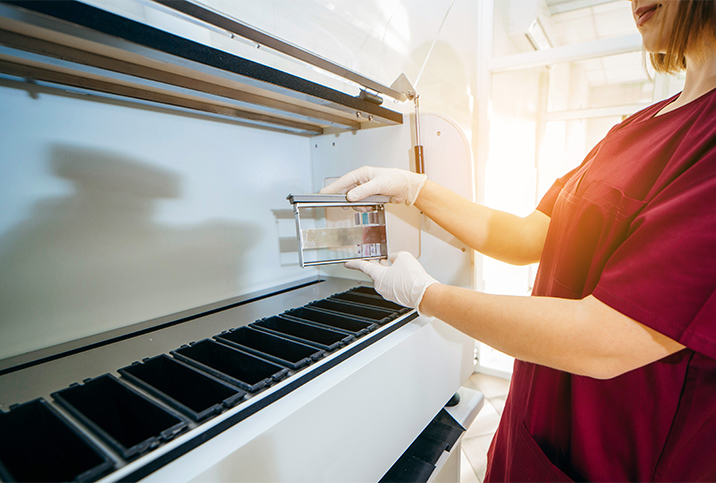Symptoms and Diagnosis of Breast Cancer

It’s a sobering statistic that an estimated 1 in 8 women will develop invasive breast cancer in their lifetime. Fortunately, treatments have progressed significantly thanks to medical breakthroughs. Effective prevention and detection methods, including recognition of symptoms, have further helped in the battle against the disease.
An overview of breast cancer
Breast cancer refers to the uncontrolled growth of abnormal cells in breast tissue. The tissues in which cancer originates—lobules, ducts and connective tissue—determines the type of breast cancer. The most common types are invasive ductal carcinoma and invasive lobular carcinoma. Both are marked by multiple risk factors, including:
-
Age
-
Genetic mutations (such as with BRCA1 and BRCA2)
-
Having dense breasts
-
A family or personal history of breast or ovarian cancer or other breast diseases
-
Previous radiation therapy and exposure to diethylstilbestrol (DES)
-
Being overweight or obese and eating a poor diet
-
Alcohol consumption and/or smoking
-
Combined hormone replacement therapy (HRT) and taking certain oral contraceptives
Treatments may include surgery, radiation, chemotherapy, hormonal therapy, targeted therapy and immunotherapy.
The role of breast exams
For decades, breast exams have played an important role in cancer detection. According to a 2011 study from the Journal of Women’s Health, 25 percent of breast cancer cases are caught by a breast self-exam (BSE).
However, perhaps surprisingly, breast self-exams are not without controversy. A 2008 report based on studies including nearly 400,000 women in Russia and China reported breast self-exams did not increase the likelihood of survival, and they might have caused harm due to unnecessary biopsies. Other studies have echoed these concerns. The American Cancer Society no longer recommends self-exams or clinical breast exams (CBEs) for women with an average risk of breast cancer. However, other prominent organizations, including BreastCancer.org, the National Breast Cancer Foundation and Johns Hopkins, still recommend BSEs at least once a month and CBEs every one to three years as a part of screening.
Your doctor can discuss the best detection practices for you. Different screening methods may be recommended for high-risk women than for those of average risk.
If self-exam is recommended, you should perform it at the same time every month, ideally three to five days after the start of your period. Begin by examining your breasts in a mirror; look for any irregularities, lumps, discoloration or swelling. Raise your arms above your head and check again, looking for changes or any nipple discharge. Then lie down on your bed and examine your breasts manually—right hand for left breast, left hand for right breast—using the pads of your fingers. Use light, medium and hard pressure in each area to examine different depths, and feel each area with a small circular motion. Start on the outer edges of your breasts and slowly work your way in toward the nipple—feeling in a clockwise manner can help prevent you from missing areas—collarbone to abdomen, armpit to cleavage.
Finally, repeat this manual exam while sitting or standing; many women find this part easiest in the shower. If you feel something, stay calm—8 out of 10 lumps are noncancerous—and schedule an appointment with your doctor for evaluation.
Symptoms
Symptoms of breast cancer vary greatly, but they tend to include a lump, mass, thickening or hardening, or swelling without a lump; change in breast or nipple size, color or symmetry; changes in the skin, including redness, flaking, dimpling and puckering; or tenderness or warmth to the touch. New inversion of a nipple or bloody or abnormal nipple discharge can be indicative, as can breast or nipple pain or irritation. You may also feel lumps or tenderness in the underarm area.
Other general symptoms may include unexplained weight loss, fatigue, nausea, chest pain, shortness of breath, coughing, bone pain (typically in the hip or back), bone fractures, numbness or weakness, pain or swelling in the ribs or right shoulder, persistent hiccups, insomnia and digestive problems. Other signs that a doctor may detect include swollen lymph nodes under the armpit or around the collar bone, an elevated calcium level in the blood, anemia and jaundice.
What’s “normal” varies dramatically from one woman to another, as do signs for concern. Research published in Cancer Epidemiology in 2017 evaluated more than 2,000 women diagnosed with breast cancer and found 83 percent noticed a breast lump as the first symptom. One in six presented with multiple symptoms other than a lump, including nipple abnormalities, breast pain and non-breast symptoms, such as back pain and weight loss.
Experiencing one or several of these signs or symptoms does not mean you have breast cancer, but you should see a doctor right away and be evaluated for additional screening.
Methods of diagnosis
Various detection methods can provide additional information to help make a diagnosis. Beyond exams, breast cancer is most commonly screened for, detected or further evaluated by diagnostic mammogram, breast ultrasound or magnetic resonance imaging (MRI).
A diagnostic mammogram provides a detailed X-ray and is often used if a lump has been detected. Mammograms are a standard element of breast cancer screening, recommended annually for women over age 45 and every two years for women over age 55. (Recommendations vary by organization. The Centers for Disease Control and Prevention has a handy chart that summarizes them.) Ultrasound uses sound waves that form a picture of the breast tissue, and it is commonly used to determine if a mass is a fluid-filled cyst or a solid tumor. A breast MRI provides an even more detailed image of tissue inside the breast and is a common screening tool for high-risk women—those with a 20 percent or greater lifetime risk of breast cancer. A breast MRI may also be used for women with dense breast tissue, a history of breast cancer, a recent diagnosis of breast cancer or when a mammogram shows a suspicious mass.
While mammography remains the most common modality for screening and detection, according to a 2011 study from the World Journal of Oncology, others are increasingly being studied for their potential to advance breast cancer screening and diagnosis. Breast tomosynthesis, or 3D breast mammography, is a newer method employed in some medical centers, along with molecular breast imaging (MBI), positron emission mammography (PEM), contrast-enhanced mammography (CEM), optical imaging tests, electrical impedance imaging (EIT) and elastography.
Characterizing breast cancer
In the past, a system designated as TNM was utilized to characterize breast cancer. It established the size and spread to nearby tissue (T), the presence in lymph nodes (N) and any spread beyond the breast (M). As of 2018, characterization also indicates tumor grade, whether the cancer cells have estrogen and/or progesterone receptors, whether they make too much HER2 protein and an Oncotype DX score. These characteristics help improve the accuracy of staging.
A breast biopsy confirms the diagnosis and provides valuable information to help characterize the cancer. There are multiple types, including fine-needle aspiration, core and open. Small samples of tissue are removed for analysis under a microscope by a pathologist who characterizes the cancer, including establishing its grade and stage. Cancer grade, which ranges from 1 to 4, refers to how abnormal cancer cells look under a microscope. Breast cancers in grades 3 or 4 tend to grow and spread faster than those in grades 1 and 2. Cancer stage refers to the spread of cancer—local, regional or distant. Staging for breast cancer is broken down into stages 0 to IV, from noninvasive breast cancer (stage 0) to advanced or metastatic cancer (stage IV). All characteristics help inform the prognosis and treatment options, with the cancer stage being the most important factor in determining treatment plans and survival rates.
Prevention
Lifestyle changes can play a significant role in reducing breast cancer risk. These are factors you can control:
-
Eat a balanced, primarily whole-foods diet and avoid meats (especially those cooked at high temperatures).
-
Get ample physical activity and maintain a healthy weight.
-
Minimize alcohol consumption and don’t smoke.
-
Avoid carcinogens in plastics, chemicals, pesticides and radioactive materials.
-
Ensure your water supply is safe.
A 2019 analysis of 180,000 women ages 50 and older found that women who lost more than 20 pounds (and kept it off) during the 10-year study benefited from a 26 percent reduction in breast cancer risk compared with women who stayed within four pounds of their pre-study weight.
Women at high risk for breast cancer should discuss additional screening with their doctor. Those with a family history of the disease or of a genetic mutation linked to breast cancer should consider genetic testing for the mutation. Genetic testing can’t prevent a diagnosis of breast cancer, nor is it the best choice for everyone, but it can inform high-risk women of their status, inform treatments and be the catalyst for lifestyle changes to reduce risk.
When breast cancer is detected and treated early, the outcome is highly successful. Stage I cancers are treated with a 90 percent five-year relative survival rate and 99 percent for invasive breast cancer located only in the breast. But breast cancer is still the number-two cancer-related killer of women: The five-year survival rate for stage III is 86 percent, but that falls drastically to 28 percent for stage IV.


















